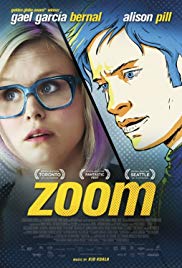
ZOOM
Brazil/Canada, 2015, 96 minutes, Colour.
Gail Garcia Bernal, Alison Pill, Tyler Labine, Mariana Ximenes, Jennifer Irwin, Don Mc Kellar, Michael Eklund, Jason Priestley.
Directed by Pedro Morelli.
Zoom is an interesting and often entertaining experiment, part of it filmed in real live-action, part of it in animation. It is a Canadian- Brazil coproduction, action taking place in both countries.
The title indicates photography, filmmaking, close-ups, movement…
The screenplay has three stories in one, each flowing from the other, a circle of stories and narratives.
Alison Pill portrays Emma, a doll maker in Toronto factory, working with Bob, Tyler Labine, with whom she has a sexual relationship. But, she is conscious of her small breasts and decides to go to a surgeon to enhance them, initially happy, then feeling awkward, then going back to have the process reversed. In the meantime, she has a customer who wants a doll made according to the specifications of his former wife. There is also a drug dealing neighbour and plot complications when the dollmakers acquire the drugs and conceal them in the model for the husband. This story is told in live-action until the end.
But Emma is also drawing, a comic strip narrative about a film director who wants his art to be transcendent, falls foul of a bossy producer, his co-director urging him to more commercial approaches. At the centre of the story is Edward, Gail Garcia Bernal, voicing his character but not actually seen, the animated version resembling him. He has his problems with the film. He also has his problems with his sexuality – and, at one stage, Emma suddenly reduces his penis size which leads to further complications, his looking for enhancement, his almost being electrocuted with the enhancement, his being pressurised to make the ending of this film more commercial.
However, there is a Brazilian model, Michelle, Mariana Ximenes, who wants to be a novelist, starts writing a story, which is the story of Emma. The model has a jealous boyfriend, Jason Priestley, and she escapes to Brazil, beginning to write, involved in a relationship with a woman at the bar, and gradually incorporated into Edward’s film.
So, each story is dependent on the other – which is tantalising, circular storytelling, for the audience.
1. The title and tone? Photography, close-ups, movement?
2. The Canadian settings, the doll factory, apartments, drugs? The Brazilian setting, the countryside, the ocean, the town, the bar? The film set? Helicopters, highways, action? The musical score?
3. The use of live action for Emma’s story, for Michelle and her story, model, photography, writing the novel, her boyfriend? For Brazil, the town, the bar, the countryside, the ocean? The contrast with the animation style for the story of Edward and his film, Marisa and her interventions, the sexual content, for the climax of the movie, no action and the sudden end, the elaborate concoctions for commercial success?
4. Emma’s story, the doll factory, her role, her appearance and her concern, the sexual liaisons with Bob during work time? Her reaction to him? The visitor, the specifications for his doll, her explanations? The visual impact of the dolls? The photo of the character with large breasts? Bob’s comment about Emma, her going to the surgeon, the discussions, his agreement, the cost? The enhancement, Emma and her reaction, with Bob, uncomfortable, returning, wanting the originals restored? The cost, the surgeon refusing?
5. Emma, her drawing the cartoon book, Edward, Gail Garcia Bernal and his not appearing in live action, his voice, in the animation? Her changing the story? The producer, her haughtiness, the co-director? Penis issues?
6. The neighbour, exercise, music? The delivery of the drugs, Emma and Bob finding them, puzzling what to do, dealers, sales, stuffing the doll – and its being collected by the owner, his flirtation with it, the dancing? The return to the factory? The pulling of the guns and the shooting – and Michelle changing her mind? The dilemmas, Emma discovering she was part of a narrative, looking for Michelle to help?
7. Michelle, in Canada, her boyfriend, writing the novel, the aquarium, the publisher interested, the boyfriend jealous, her not having written anything? Her note and going back to Brazil, her life there, the proprietor of the bar, the sexual relationship? Going to the water, diving into the water? The ideas for the novel, creating Emma, the development of her story?
8. Michelle in the animation, caught up in the film, as a character, with the boyfriend, the commercial overtones of plot, the rescue, the helicopter, on the highway? The issue of her book, being urged to throw it out of the helicopter, her diving out, recovering it? Her relationship with the characters in her novel?
9. Edward, his film, wanting to be transcendent, his co-director, the non-commercial ending with Michelle diving into the water? The discussions about Hollywood, Marisa as the dominant producer, her demands, not liking the ending of the film? Edward, sexual behaviour, the girls, Emma diminishing his penis, his going to the shop to buy an enlargement, wearing it, going into the water, people admiring him, the electric shock? Marisa and her approach, his embarrassment, his being enhanced? The co-director and the consultation about the film, the going to Brazil? The scenes, his moods, the changes?
10. The circle of the narratives, each creating the other – and its affect the continuity, the audience, switches reality to animation? The tongue-in-cheek approach of the film?